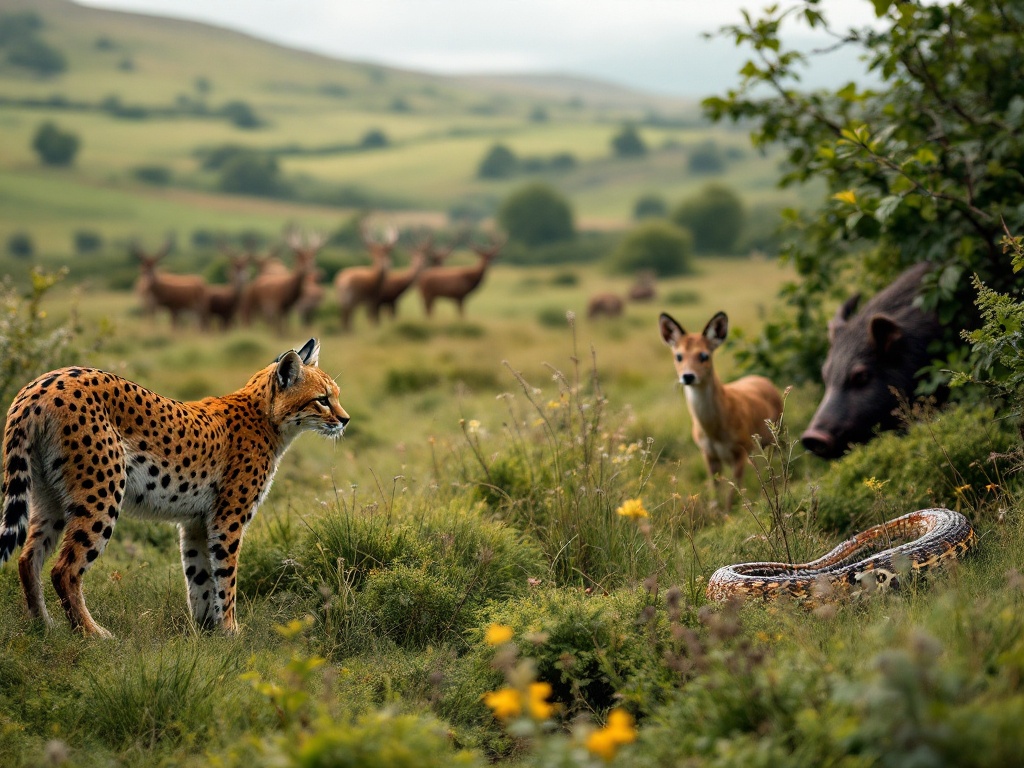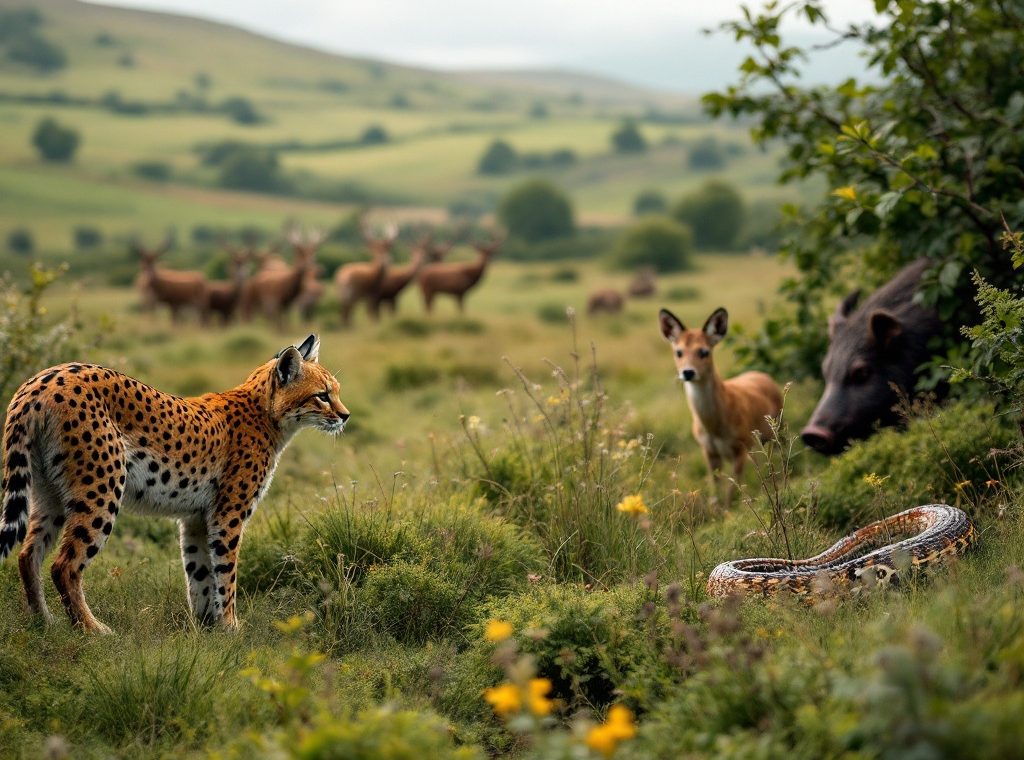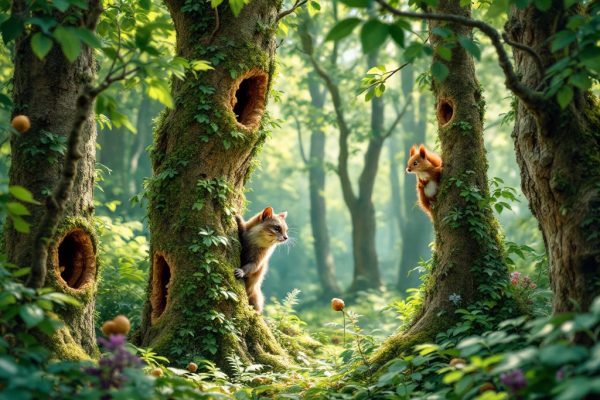Most Dangerous Wild Animals in Lothian, Scotland
Exotic pets like servals, caracals, and even venomous snakes are lurking in Lothian, Scotland! Beyond private collections, native adders, aggressive red deer, and unpredictable wild boar roam free. Discover the surprising dangers lurking in Scotland’s idyllic landscape, from exotic predators to Lyme disease-carrying ticks. Learn how to stay safe and protect yourself while exploring Lothian’s natural beauty. Read on to discover essential safety tips and fascinating insights into Scotland’s diverse and sometimes dangerous wildlife.
Important information

- Adders are Scotland’s only venomous snake. Their bite, while rarely fatal, requires immediate medical attention due to pain, swelling, and potential dizziness.
- Red deer stags are aggressive during mating season, posing a risk to humans with their antlers. Maintaining a safe distance is crucial.
- Wild boar, though not native, are present and can be aggressive, especially mothers protecting young. Avoid approaching them.
- Ticks transmit Lyme disease, a serious illness with long-term health consequences if untreated. Use repellent and protective clothing, and remove ticks promptly.
- Exotic wild cats like servals and caracals are kept as pets, posing a risk if they escape. Their unpredictable nature requires specialized care and secure enclosures.
Most Dangerous Wild Animals in Lothian, Scotland
Lothian, Scotland, is home to a surprising variety of dangerous creatures, both wild and domestic. Privately owned exotic animals add to the mix, with species like servals, caracals, and even crocodiles such as the Broad Snouted Caiman and Nile Crocodile. Venomous snakes, including the Western Diamondback Rattlesnake and Death Adder, also reside in private collections. Even some primates, like the Ring-tailed Lemur, can pose a threat. Large animals like bison, wild boar, zebras, and ostriches also call Lothian home.
Wild animals
Beyond private collections, Lothian’s native wildlife presents its own set of hazards. Adders, Scotland’s only venomous snake, are a prime example. Red deer, aggressive during mating season, are another potential danger. Wild boar, known for their unpredictable behavior, may charge if provoked.
- Ticks carrying Lyme disease represent a less visible but significant threat.
- Even large birds of prey, such as golden eagles, can be dangerous to small pets.
Domestic animals
Domesticated animals also pose risks. Cows cause the most injuries and fatalities in Scotland, becoming particularly protective during calving season. While not domesticated, deer contribute to numerous road accidents, especially in autumn.
Therefore, while Scotland may appear idyllic, it’s crucial to be aware of these potential dangers.
Wildlife Dangers in Lothian
Lothian’s diverse wildlife, both native and non-native, presents certain risks to people. Native red deer, particularly during rutting season, can become aggressive, leading to thousands of vehicle collisions across the UK annually. Adders, Scotland’s sole venomous snake, are typically not aggressive but will bite if threatened, causing localized pain and swelling. Wild boar, especially mothers with young, can also be dangerous if approached. Ticks, common throughout the region, transmit Lyme disease, a serious bacterial infection with potential long-term health consequences if left untreated. Adding to these natural hazards are exotic animals like servals and caracals. Though not native, they are sometimes kept as pets and occasional escapes pose a public safety risk. So, be mindful of these potential dangers when exploring Lothian’s natural beauty.
Native Wildlife Risks
- Red deer: Aggressive during rutting season, causing numerous vehicle collisions.
- Adders: Scotland’s only venomous snake; bites cause localized pain and swelling.
- Wild boar: Protective mothers can be dangerous if approached.
- Ticks: Transmit Lyme disease, a serious bacterial infection.
Non-Native Wildlife Risks
Exotic pets, such as servals and caracals, can pose a risk if they escape.
Animal Aggression and Encounters
While aggressive animal encounters are rare in Lothian, provoking animals can lead to attacks, especially with species like the jaguarundi. Exercise caution near areas housing these animals, such as private collections. Respecting wildlife and maintaining a safe distance minimizes danger. Understanding animal behavior is also crucial for safety. For example, avoid approaching or feeding wild animals, learn to recognize signs of aggression or distress, and never corner an animal or block its escape route. If confronted by an aggressive animal, try to appear large and make loud noises, but avoid direct eye contact. Slowly back away without turning your back on the animal, and if attacked, protect your head and neck.
Breeding Season and Increased Risks
When exploring Lothian, be mindful of the local wildlife, especially during breeding seasons. Animals can be more protective of their young during these periods, and mothers may exhibit increased aggression if they perceive a threat. For example, cows with calves may react defensively to your presence. Always prioritize your safety and observe wildlife from a respectful distance.
Common Dangerous Animals Native to Scotland
Scotland’s wilderness harbors a few creatures that demand caution. The adder, Scotland’s sole venomous snake, can deliver a bite requiring immediate medical care. While majestic, red deer, particularly stags during the rut, can become aggressive, wielding their antlers as dangerous weapons. Wild boars, also known for their aggression, pose a potential threat, though encounters are infrequent. Finally, the tiny tick presents a considerable risk, as it can transmit Lyme disease. Therefore, it’s crucial to guard against tick bites when venturing into Scotland’s countryside.
Creatures to be cautious of in Scotland
- Adders: Scotland’s only venomous snake, their bite requires immediate medical care.
- Red deer: Majestic but potentially aggressive, especially stags during rutting season, using their antlers as weapons.
- Wild boars: Known for aggression and posing a potential threat, though encounters are rare.
- Ticks: Tiny but significant, carrying the risk of Lyme disease transmission.
Safety advice when exploring the Scottish countryside
Be mindful of your surroundings, particularly in areas where these creatures might reside. Wear appropriate clothing, such as long trousers and sturdy boots, to minimize the risk of tick bites and other encounters. Consult local guidelines for wildlife safety and be prepared for potential hazards.
The Adder: Scotland’s Venomous Snake
Scotland’s only venomous snake, the adder, prefers habitats such as heathland and woodland. While generally not aggressive, adders may bite if startled or threatened. Bites, though painful and potentially causing swelling and dizziness, are rarely fatal. However, prompt medical attention is crucial if bitten.
Red Deer and Antlers
Male red deer possess magnificent antlers, which transform into formidable weapons during mating season. Stags aggressively defend their territory, becoming a potential danger even to humans. Their sharp antlers can inflict serious injuries, especially during the rut. Therefore, approach these animals with extreme caution, and prioritize safety by observing them from a distance. For your safety, consider these precautions:
- Maintain a safe distance, especially during the rutting season.
- Never approach a stag, as they can be unpredictable and dangerous.
- Avoid disturbing them, as this may provoke an attack.
Wild Boar Encounters
Wild boars, though not native to Scotland, have been sighted, and caution is advised. These animals, especially sows with piglets, can be aggressive. If you encounter a wild boar, remain calm and retreat slowly. Do not approach or provoke the animal. Avoid areas known to harbor boars, particularly during feeding or breeding seasons. Never approach an injured boar.
Ticks and Lyme Disease
Lyme disease is transmitted through tick bites, often presenting flu-like symptoms such as rashes, fatigue, and other similar indicators. Untreated Lyme disease can lead to significant long-term health problems. Fortunately, preventive measures can be taken.
Use tick repellent and wear protective clothing in tick-infested areas. This will minimize your exposure to ticks and reduce the risk of bites.
Remove ticks promptly, ideally using a tick removal tool. Quick removal minimizes the transmission of bacteria that cause Lyme disease.
Monitor the bite area for any developing rash or signs of infection. Early detection of a rash or flu-like symptoms is crucial for prompt treatment.
Seek immediate medical attention if a circular rash or flu-like symptoms appear. Antibiotics are essential for preventing long-term health complications associated with Lyme disease.
Wild Cats and Other Predators in Lothian
Exotic wild cats, such as servals and caracals, are becoming increasingly popular pets in Lothian, with at least 21 currently kept in homes. While these animals are captivating, they present a substantial risk, especially to smaller animals if their enclosures are not fully secure. Humans are also potentially at risk.
Servals and Caracals: Exotic Wild Cats
Exotic wild cats, such as servals and caracals, are appearing as pets in Lothian, Scotland. This raises concerns about their specialized care and handling, as these animals can be unpredictable and potentially aggressive. Adding to the issue, F1 Savannah cats, which also have unique care requirements, are present in the region.

















